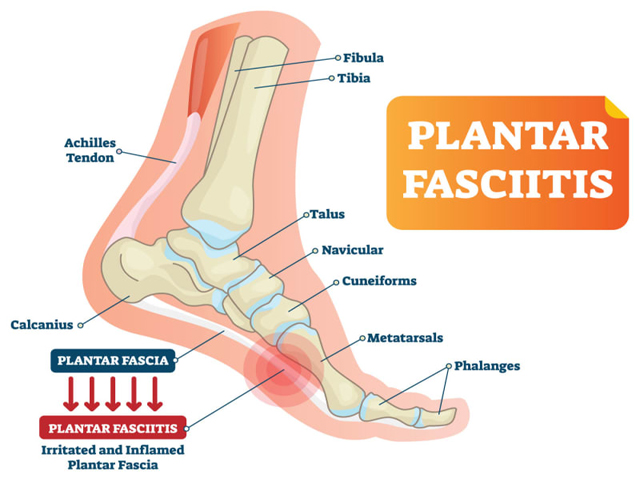




Healthy feet have strong, wonderfully flexible ligaments which are designed to support standing, walking and running. Plantar Fasciitis is defined as inflammation of, or damage to, one of the most important ligaments in the foot - the plantar fascia.
The plantar fascia ligament is located along the sole of your foot. It is made up of fibrous tissue that stretches outward from the heel bone, like a strong piece of elastic, and then branches out across the arch and through the ball area of the foot toward the toes.
This ligament is meant to support the bounce and spring of normal daily activity, but in the case of Plantar Fasciitis, the plantar fascia is stretching and moving more than it should, resulting in small tears in the tissue. These tears create a condition of inflammation. Additionally, calcium build-ups, called bone spurs, may form on the heel bone. These pointed or shelf-shaped bony protrusions are then pressed into the fatty pad of your heel with each step you take, causing further pain.
The term "Plantar Fasciitis" is literally translated as "Foot Inflammation". It is a progressive condition. If left untreated, the combination of excessive movement of the ligament, small tears, inflammation and possible bone spurs can become debilitating to the sufferer. Fortunately, there are excellent, natural options for resolving the pain of this ailment.

Aching, sharp or burning pain in the sole of your foot, often centering in the heel area. Foot pain that occurs as soon as you step out of bed or get to your feet after prolonged periods of sitting. Pain may decrease eventually after you've been on your feet for a while. It may be associated with limpung. It may involve both feet or one foot. It may also be associated with swelling, redness and burning sensation in heel area.
Plantar Fasciitis is frequently cited as the number one cause of heel pain. The condition affects both children and adults. Children typically outgrow the problem, but affected adults may experience recurring symptoms over the course of many months or years. The syndrome afflicts both highly active and sedentary individuals.
Typically, Plantar Fasciitis results from a combination of causes, including:
-Overuse of the feet without adequate periods of rest.
-High arches, flat feet or tightness in the Achilles' tendon at the back of the heel.
- Obesity
-Working conditions that involve long hours spent standing or lifting heavy objects.
-Worn or ill-fitting footwear.
-The normal aging process, which can result in a loss of soft tissue elasticity.
- Physical trauma to the foot, as in the case of taking a fall or being involved in a car accident.

Treatment options for this condition involve taking medications, having injections or undergoing surgery. While these remedies may be necessary in some cases, there are natural, non-invasive, affordable methods for treating and healing Plantar Fasciitis. A simple, three-step approach may be all you need to experience immediate or rapid symptom relief.
When a ligament is stressed and inflamed, it is absolutely essential to take pressure off it and let it rest. Adjust your daily habits to spend some time each day off your feet
Apply an ice bag or cold pack to your heel for twenty minutes, twice a day. This will numb soreness and help control inflammation.
Orthotics are devices designed to modify body motions or lessen pressure on areas of the body. In the case of foot orthotics, these products may include splints, wraps and shoe inserts.
Website Designed By: Quick n Host